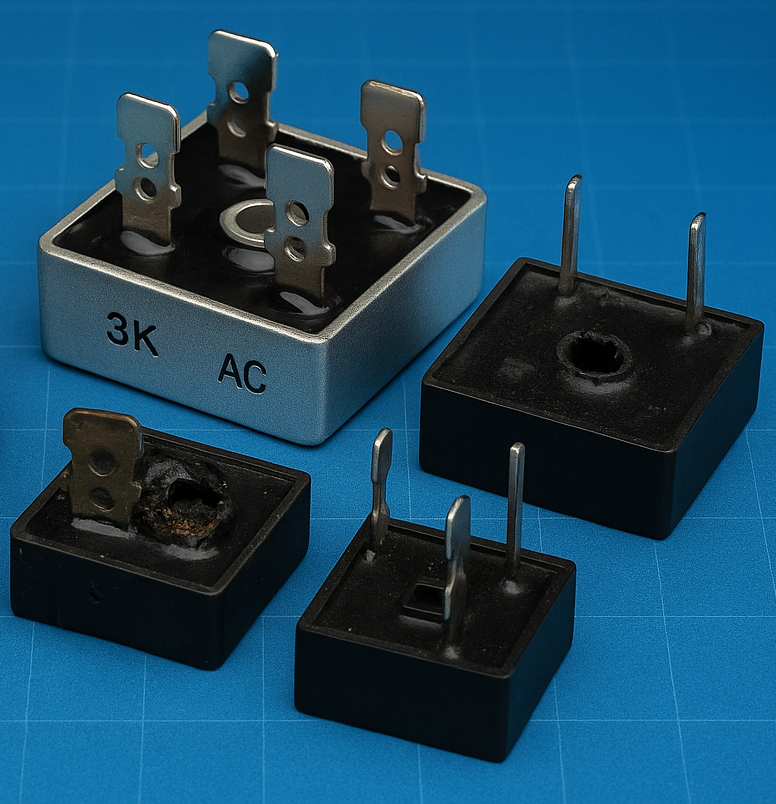Ushbu maqola standart most to'g'rilovchilarning uchta keng tarqalgan ishlamay qolish rejimlarini—qisqa tutashuv, qaynoq harorat va impul's ta'siri—tahlil qiladi hamda elektr muhandislari uchun quvvatli dizaynlarni optimallashtirish va tizimlarning ishonchliligini oshirish bo'yicha amaliy muhandislik choralari taklif etadi.

Kirish
O'zgaruvchan tokni doimiy tokka aylantirishda ishlatiladigan standart toshkino to'g'rilagich adapterlar, elektr manbalari, yoritish dvigatellar, maishiy asboblarda va sanoat jihozlarida keng qo'llaniladi. Uning oddiy zanjirli tuzilishi sababli ham real dasturlardagi nosozliklar butun tizim ishonchliligini ta'minlash uchun asosiy omil bo'lib qolmoqda.
Nosozlik rejimi 1: To'g'rilagich zanjiri
Umumiy belgilar: Kirish sig'imi o'tadi, Chiqish kuchlanishi yo'q, Elektr platada yonish belgilari
Asosiy sabablari:
Chiqishdagi ortiqcha yuklama yoki zanjir: ortiqcha tok PN o'tishini buzadi
Issiqlik to'planishi: uzok muddatli qizib ketish chip strukturasi yemirilishiga olib keladi
Kiritish tokining sakrashi: himoyasiz tok berish diodlarni shikastlaydi
Oldindan jarayonlar: Tez yonuvchi predoxranitellarni yoki PTC termistorlarni o'rnatish, Kirishda NTC yoki MOV supressorlardan foydalaning, To'g'rilovchi tokning reytingi ≥ 1.5–2× cho'qqi yuk tokining
Nosozlik rejimi 2: To'g'rilovchining qizib ketishi
Umumiy belgilar: Chiqish kuchlanishining nobarqarorligi, Quti rangining o'zgarishi yoki pishishi, Issiqlik zonasiga yaqin joylarda lokal yallig'lanishlar
Asosiy sabablari: Qurilma tanlovining past baholanishi, uzun muddatli ortiqcha yuklama. Yomon issiqlik muhandisligi, PCBdan radiatori sovutishga bo'lgan aloqaning zaifligi. Odatdagi muhit harorati yuqori yoki havo oqimining yetishmasligi
Oldindan jarayonlar: KBPC yoki GBJ kabi radiatori birlashtirilgan paketlardan foydalaning, Issiqlik tarqalishini yaxshilash uchun PCBda mis maydonni kengaytiring, O'tkazishni yaxshilash uchun termopasta va aluminiy plastinkalardan foydalaning
Nosozlik rejimi 3: Tok tashabbusining ta'siri
Umumiy belgilar: Tok ulanganida qurilma darhol ishdan chiqadi, Diodelarning qisqa tutashuvi, Katta kondensatorli filtrlarda noaniq xatti-harakatlar
Asosiy sabablari: Katta kirish kondensatorlarining dastlabki zaryadlanishi, Tok tashabbusi maksimal impul's tokidan (IFSM) oshib ketadi, Impul's chegarasini belgilovchi komponentlarning yetishmasligi
Oldindan jarayonlar: Filtr kondensatorini to'g'ri o'lchash, Tokning ortishini sekinlatish uchun ketma-ket NTC termistorni qo'shish, IFSM ≥ 2× kutish bilan kelgan tok tashabbusiga ega to'g'rilovchilarni tanlash
Xulosa
Kichik bo'lsada, standart to'rt tomonlama to'g'rilovchi kuchlanish tizimining barqarorligida muhim rol o'ynaydi. Uni nosozlik mexanizmlarini tushunib, ilgarilab ketuvchi loyihalash choralari qo'llanilsa, muhandislar tizimning xizmat muddati va ishonchliligini keskin oshirishlari mumkin.